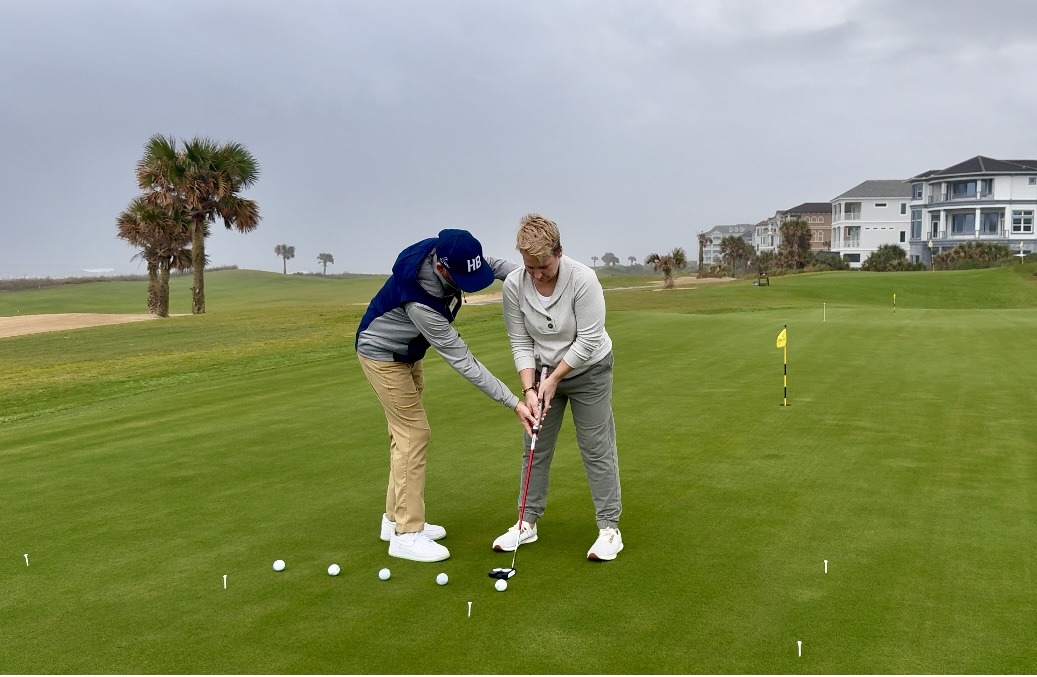The Club At Hammock Beach Blog

Pro Golf Tips: How Golf Lessons Can Improve Your Game
- March 13 2025
- The Club at Hammock Beach
Golfers who master their putting save an average of four strokes per round—a surprising statistic that transforms weekend frustration into tournament-ready precision. As Jack Nicklaus famously observed, “Golf is a game of inches,” and there are many pros who would agree. One moment, a putt glides effortlessly into the cup; the next, it veers inexplicably out of line with the hole. The difference between success and failure often lies in swing length, moment-to-moment tempo shifts, and the confidence to stop second-guessing every stroke. PGA professionals don’t just help you practice—they help you evolve.
For players attempting to conquer these nuances, structured coaching is not a luxury—it’s a game changer. At The Club at Hammock Beach, golf lessons and clinics break down the game’s complexities into actionable, transformative skills. Starting with the simple beginner items, like chipping and putting, are the elements Tiger Woods' father used, instructing Tiger to start at the green and move back to the tee, focusing first on chipping and putting. This method was the foundation for Tiger’s incredible short game and his eventual dominance in the sport.
The Fastest Way to Improve? Expert Coaching
A 2019 USGA study found that golfers with structured short-game lessons reduced their three-putt percentage by nearly 40%. Precision, it turns out, is a science—not luck. Yet too many players lean on repetition over strategy, grinding through buckets of balls without addressing the root causes of inconsistency. This is where drills, like those created by Golf Pro Walter Messer at The Club at Hammock Beach, prove their worth.
Guidance from the pros provides players with tailored drills, real-time feedback, and the tools used by tour professionals. These lessons focus on things from swing mechanics to learning by feeling and turning weaknesses into strengths.
Mastering the Art of Putting: Beginner Golf Drills for Precision and Control
Putting is where games are won or lost. The perfect putt blends technical precision and intuitive feel—a balance best achieved through targeted drills. But even the best golfers will tell you: golf does not demand perfection; it demands improvement. Four foundational exercises tackle the critical components of putting mastery.
1. Length of Swing: The Ball-Behind-Ball Drill
Distance control starts with swing length. A longer backswing generates more power, but overdoing it sends the ball racing past the cup. The Ball-Behind-Ball Drill eliminates guesswork:
- Place a second ball about 4 inches behind your putter head, aligned with your target line.
- During your backswing, stop when the putter head reaches the trailing ball.
- This visual cue trains the novice in consistent swing length, keeping swings shorter and less powerful.
2. Pace of Swing: The Tick-Tock Tempo
Rhythm is the heartbeat of a reliable stroke. The Tick-Tock Drill uses the very words themselves to synchronize backswing and follow-through:
- Start your backswing on the first beat (tick), follow through on the second (tock). Saying the words out loud helps retain focus and rhythmic beat.
- Zero in on maintaining equal backswing and follow-through lengths.
- Concentrate on the movement of your body, hinging at the hips and lowering your grip in a relaxed state.
This drill not only controls jerky strokes but also builds internal rhythm.
3. Feel Development: The Eyes-Closed Drill
As golf legend, Ben Hogan says: Great putters “see” with their hands. The Eyes-Closed Drill sharpens tactile feedback:
- Set up putts that vary in distance, then close your eyes before striking.
- Focus on the weight of the putter head and the ball’s response off the face.
- Open your eyes only after the ball stops.
This exercise heightens sensitivity to speed and slope, ultimately helping the player know where the ball will go based on their body's weight, movement, and position.
4. Centeredness of Contact: The Sweet Spot Challenge
Mishits cost distance and accuracy. Use impact tape or a dry-erase marker to test strike quality:
- Draw a line on your ball and align it with your putter’s sweet spot.
- After each putt, check if the line transfers cleanly to the clubface.
- Adjust stance or ball position until contact is consistently centered.
Why Golf Lessons and Clinics Are a Game-Changer
These drills aren’t just golf theory—they’re tried and true methods used by PGA professionals to shave strokes off players' game. However, the real power of coaching lies in customization and, ultimately, the instructor's patience. A trained instructor identifies flaws invisible missed by the untrained eye: a grip too tight or high, a shoulder out of alignment, eyes fixed on the ball instead of the target, and too much movement in the wrists rather than the arms.
The Stats: Data-Backed Proof of Progress
- Golfers with professional coaching improve 2x faster than those self-teaching (National Golf Foundation).
- Golfers who kept track of their playing stats showed an average handicap improvement of 3.38 shots
- According to Keiser University College of Golf, players working with Pros average a 3.8-stroke handicap drop within a year of starting weekly clinics.
The Investment: ROI Beyond the Scorecard
Golfers widely recognize that golf is a lifelong pursuit—but stagnation breeds frustration. Lessons pay dividends in confidence, enjoyment, and even player relationships forged on the course. As one Hammock Beach member noted after enrolling in a series of clinics at the club: “I finally look forward to par-3s instead of dreading them.”
Ready to Transform Your Game?
The Club at Hammock Beach merges world-class coaching with two of Florida’s most breathtaking courses. No matter if your priorities are chasing scratch or simply improving your short game, every lesson is a step toward more confidence on the course.
Most golfers would agree-golf isn’t just a game—it’s a life-long mission of improvement, so why go it alone? It begins with precision, purpose, and the proven advantage of expert coaching.
Want to listen to our podcast on this topic? Click Here!

